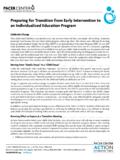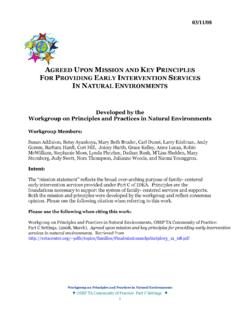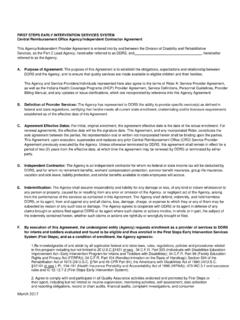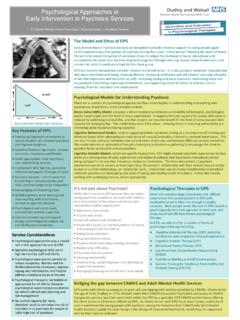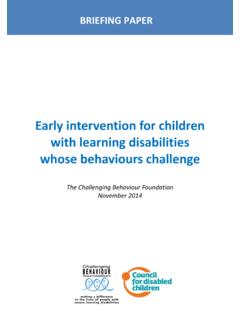Transcription of Interventions for Divorced Parents and Children - …
1 Divorce as a Family transition Interventions for Divorced Parents and Children Prof. Dr. Wassilios E. Fthenakis Director of the State Institute of early Childhood Education and Research, Munich University of Augsburg Introduction Demographic and psychological studies show that Children and adults from Divorced families utilise pro- fessional counselling two to three times more frequently than members coming from intact families to cope with problems in connection with separation and divorce. Research on divorce has well documented the consequences of separation and divorce for Children and Parents (Amato & Booth, 1997; Fthenakis, 1995a, 1995b; Fthenakis et al.)
2 , 1982; Hetherington, 1999; Lamb et al., 1999; Thompson & Laible, 1999;. Thompson & Amato, 1999). During the last ten years a new paradigm regarding the phenomenon of di- vorce has been introduced which shows that a divorce is not the end of a family, but leads to its reorgani- sation. Recently the Family- transition Approach and the Risk and Resiliency Perspective have contrib- uted towards reconceptualizing the phenomenon of divorce as a transition phase in the process of family development. These approaches have provided a theoretical base which is proving to be increasingly help- ful for the development and evaluation of intervention measures before, during, and after divorce.
3 Parallel to this development there has been a paradigm shift in legislation measures. During recent years most established systems of law follow the idea that whereas marriage and partnership may end, parent- hood remains lifelong with both Parents . Therefore they try to adopt a philosophy of parental autonomy . and behave very cautiously if the parent's rights are intruded. The German Federal Constitutional Court for example has set up a guideline that states that a government intervention in parent's law is only permitted if all possible measures have failed to restore impaired paren- tal competence by utilising intervention approaches.
4 Also the concept of empowerment in youth services calls for a radical shift away from the protection of their clients and propagates a model of "human strengths" as a new orientation for professional workers. Since the reformed Child Law of July 1998 has been in effect, the obligation to accept professional guid- ance has been extended for separated and Divorced families in Germany. The state has partly withdrawn from involvement in Divorced families and has agreed upon and approved more or less binding intervention programs to give internal autonomy to the family instead of legal mecha- nisms.
5 Against this background one can understand that during the past twenty years a series of intervention approaches have been developed, and to a certain extent implemented, and evaluated to meet this paradigmatic change concerning Divorced families. Already since the seventies and early eighties many intervention approaches have been developed and partly evaluated which focus either on partnership or parenthood or Children . Relevant review articles have been published by Blaisure & Graesler (1999); Grych & Finchman (1992, 1999); Emery (1999), Glaeser & Blaisure (1998).
6 For example, during the last ten years programs for Divorced Parents have been developed to ease transi- tion to joint parenthood. Such programs focus on an education towards mental health. Normally they are short-term measures, limited in time. They utilise directive, didactic approaches regarding the conse- quences of divorce on Children and, at the same time give Parents a positive attitude and essential tools for joint parenthood, intending to make the adjustment easier for the Children (c. f. Mc Kenry, Clark & Stone, 1999).
7 One can find successful Interventions in numerous fields, such as for example prevention of child 1. abuse, affective disorders of adolescents as well as of Parents . The programs have various focuses, but on the whole they try to meet three different options which are: a) mediation of divorce-specific abilities, b) a change of attitudes and c) the training of specific skills. Concerning the structure and organisation of the program there are a number of different approaches; they depend on the quantity and duration of meetings, time, location, cost, format and manner of strategies and techniques.
8 Davidoff & Schiller (1983) recom- mend a period of 6 to 8 weeks for the adult focused program and Crosbee- Burnett & Newcomer (1990). recommend 8 to 10 meetings for the child-focused program. The most effective period of time for a ses- sion with Parents is between 2 and 3 hours and for Children less than one hour. Adult groups vary in num- ber from 5 to a maximum of 15 participants and Children 's groups from 6 to 8. Within the scope of this paper it is impossible to discuss all existing approaches. Therefore I want to con- centrate on three priorities that gained importance during recent years and to give an overall view of the development in the field of divorce intervention.
9 These are a) child- intervention programs, b) educational programs ordered by the court und c) supervised visitation1. And, again, details about these Interventions are not possible, so I will try to focus on one basic problem of each intervention research that I mention. 1. I have to give up my original intention to deal with divorce intervention in this paper, because it is impossible to discuss such a detailed topic in such a short time. However, in my manuscript I pointed to the most important evaluation studies in divorce mediation.
10 Australia: Bordow, S. & Gibson, J. (1994). Evaluation of the family court mediation service. Sydney: Family Court of Australia Re- search and Evaluation Unit. Love, A., Moloney, L. & Fisher, T. (1995). Federally-funded family mediation in Melbourne: Outcomes, costs and client satisfaction. (Office of Legal Aid and Family Services, Attorney-General s Dept., Barton, ACT 2600). Austria: Bundesministerium f r Umwelt, Jugend und Familie (Hrsg.) (1997). Familienberatung bei Gericht - Mediation - Kinderbe- gleitung bei Trennung der Eltern.


